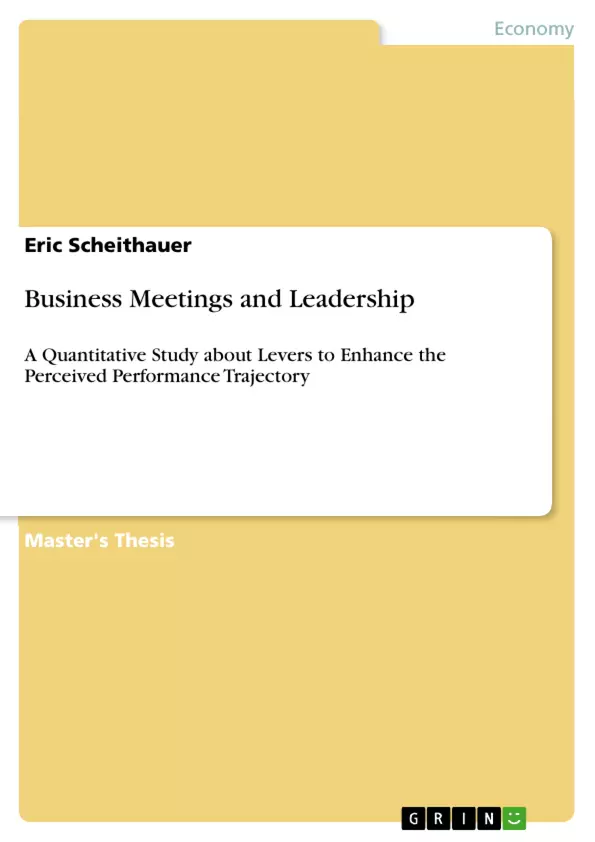Over the last years, the global market environment has rapidly evolved. Disruptive innovations have altered the technological landscape and turned existing business models and ways of operating upside down. In this highly dynamic environment, organizations and leadership face a multitude of different challenges, as new market players have emerged and fierce competition is on the rise.
Today, it is crucial to embrace specific organizational skills and behaviors to stay relevant in the future. In a volatile, uncertain, complex and ambiguous (VUCA) business context, these are key to stay competitive and to lay solid foundations for future growth.
To facilitate this, organizations have strived to make their processes as efficient and effective as possible. Remarkably, they have yet not unlocked the improvement potential that is associated with business meetings.
As a matter of fact, business meetings have not only become an indisputable part of daily business operations all around the world, but also a subject that is often perceived as costly, unproductive and dissatisfying.
The purpose of this work is to both advance the current research on business meetings at the intersection with leadership and provide actionable insights for businesses on how to enhance their organizational performance in practice.
By using a quantitative study to analyze 301 responses gathered from an online survey and test associated hypotheses, insights about the current state of meeting usage and their implications on organizational performance, based on perceived meeting satisfaction and outcomes, were identified.
Essentially, when trying to optimize their performance trajectory, organizations need to focus on a triad of meeting performance, consisting of meeting design, behavior and communication, and meeting technology.
If the insights are taken seriously and the suggested solutions are implemented in practice holistically, organizations will have the opportunity to reap the benefits of enhanced performance while cutting costs by around USD 8.5 million annually.
Inhaltsverzeichnis (Table of Contents)
- Executive Summary
- List of Abbreviations
- List of Figures
- List of Tables
- 1 Introduction
- 1.1 Background
- 1.2 Importance for Meeting Science and Business Practice
- 1.3 Need for Optimization
- 1.4 Structure of the Work
- 2 Business Meetings and Effective Leadership
- 2.1 Business Meetings
- 2.1.1 Meeting Definition
- 2.1.2 Meeting Process and Design Characteristics
- 2.1.3 Meeting Types
- 2.1.4 Meeting Purposes
- 2.1.5 Meeting Time Demand
- 2.1.6 Meeting Expenditures
- 2.2 Effective Leadership
- 2.2.1 Leadership Definition
- 2.2.2 Leadership Styles and Effective Leadership Skills
- 2.2.3 Effective Leadership in Business Meetings
- 2.3 Roles and Responsibilities Matrix for Business Meetings
- 2.1 Business Meetings
- 3 Statement of Purpose and Research Design
- 3.1 Statement of Purpose
- 3.2 Research Questions and Hypotheses
- 3.3 Research Design
- 3.4 Target Group and Sample
- 3.5 Instruments and Procedures
- 3.6 Data Analysis
- 4 Results and Hypothesis Testing
- 4.1 General and Social Demographics
- 4.2 Meeting Design Characteristics
- 4.2.1 Effects on Perceived Meeting Outcomes
- 4.2.2 Effects on Perceived Meeting Satisfaction
- 4.3 Meeting Behavior and Communication
- 4.3.1 Effects on Perceived Meeting Outcomes
- 4.3.2 Effects on Perceived Meeting Satisfaction
- 4.4 Meeting Technology
- 4.4.1 Effects on Perceived Meeting Outcomes
- 4.4.2 Effects on Perceived Meeting Satisfaction
- 4.4.3 Effects on Meeting Process
- 4.5 Roles and Responsibilities Matrix
- 4.5.1 Effects on Meeting Outcomes
- 4.5.2 Effects on Meeting Satisfaction
- 5 Discussion
- 5.1 Implications for Meeting Science
- 5.2 Implications for Organizations and Leadership
- 5.3 Levers to Enhance the Perceived Performance Trajectory
Zielsetzung und Themenschwerpunkte (Objectives and Key Themes)
This work aims to contribute to the existing research on business meetings and leadership by providing practical insights into enhancing organizational performance. The study analyzes 301 responses from an online survey, testing hypotheses about the impact of meeting design, behavior, communication, and technology on perceived meeting satisfaction and outcomes. This analysis aims to identify the most effective levers for organizations to utilize when optimizing their performance trajectory. The key themes explored in this study include:- The importance of meeting design, behavior, communication, and technology for successful business meetings
- The influence of meeting characteristics on perceived meeting outcomes and satisfaction
- The relationship between meeting practices and organizational performance
- The role of leadership in driving effective meeting practices
- Identifying actionable insights for organizations to enhance their performance trajectory
Zusammenfassung der Kapitel (Chapter Summaries)
The introduction provides context for the study by outlining the evolving business landscape and the growing importance of effective organizational skills and behaviors in this dynamic environment. It highlights the critical role of business meetings and the need to optimize their performance in order to maximize efficiency and drive organizational growth. Chapter 2 examines the concept of business meetings and their relationship with effective leadership. It delves into meeting definitions, characteristics, types, purposes, time demands, and associated expenditures. This chapter also explores leadership styles and effective leadership skills, highlighting the importance of these factors in facilitating productive business meetings. Chapter 3 presents the statement of purpose, research questions, and hypotheses guiding this quantitative study. It details the research design, including the target group, sample, instruments, procedures, and data analysis methods employed. Chapter 4 presents the results of the study, analyzing data gathered from the online survey. This includes the general and social demographics of the respondents, as well as detailed insights into the effects of meeting design, behavior, communication, and technology on perceived meeting outcomes and satisfaction. Chapter 5 discusses the implications of the research findings for both meeting science and organizational practice. This chapter highlights the key levers that organizations can utilize to enhance their perceived performance trajectory and achieve improved meeting outcomes.Schlüsselwörter (Keywords)
The primary keywords and focus topics of this study include business meetings, organizational performance, leadership, meeting design, meeting behavior, communication, technology, perceived meeting satisfaction, perceived meeting outcomes, and performance trajectory. The work investigates the relationship between these elements and their impact on organizational effectiveness.- Quote paper
- MBA, B.Eng Eric Scheithauer (Author), 2017, Business Meetings and Leadership, Munich, GRIN Verlag, https://www.grin.com/document/384213



